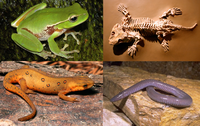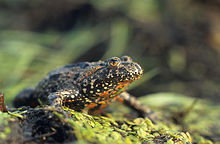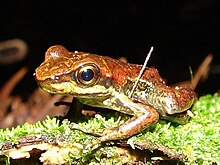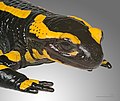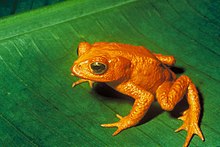Introduction
Selected amphibian type
Toad is a common name for certain frogs, especially of the family Bufonidae, that are characterized by dry, leathery skin, short legs, and large bumps covering the parotoid glands.
A distinction between frogs and toads is not made in scientific taxonomy, but is common in popular culture (folk taxonomy), in which toads are associated with drier, rougher skin and more terrestrial habitats. (Full article...)
Selected frog article
Hylodidae, commonly known as giant Neotropical torrent frogs, is a family of frogs native to Brazil and northern Argentina. Phylogenetic evidence suggests the Hylodidae being the sister group to the Alsodidae.
Megaelosia goeldii is one species that lost the ability to produce vocalizations which in turn is denoted as mute. Through observation of aggressive interactions, it was found that the species' vocal sacs are used for one form of its visual signaling and communication. (Full article...)
Selected salamander article

The greater siren (Siren lacertina) is an amphibian and one of the five members of the genus Siren. The largest of the sirens and one of the largest amphibians in North America, the greater siren resides in the coastal plains of the southeastern United States. (Full article...)
The page "User:The Transhumanist/Sandbox144/box-header" does not exist. The page "User:The Transhumanist/Sandbox144/DYK/21" does not exist.
Picture slideshow
Selected toad article
The golden toad (Incilius periglenes) is an extinct species of true toad that was once abundant in a small, high-altitude region of about 4 square kilometres (1.5 sq mi) in an area north of the city of Monteverde, Costa Rica. It was endemic to elfin cloud forest. Also called the Monte Verde toad, Alajuela toad and orange toad, it is commonly considered the "poster child" for the amphibian decline crisis. This toad was first described in 1966 by herpetologist Jay Savage. The last sighting of a single male golden toad was on 15 May 1989, and it has since been classified as extinct by the International Union for Conservation of Nature (IUCN). (Full article...)
Selected caecilian article
Chikila fulleri, also known as the Kuttal caecilian, Fuller's caecilian, and Fuller's chikila, is a species of caecilian from South Asia. In 2012 it was reassigned to a newly erected family, Chikilidae. (Full article...)
Categories
Topics
Related portals
Associated Wikimedia
The following Wikimedia Foundation sister projects provide more on this subject:
-
Commons
Free media repository -
Wikibooks
Free textbooks and manuals -
Wikidata
Free knowledge base -
Wikinews
Free-content news -
Wikiquote
Collection of quotations -
Wikisource
Free-content library -
Wikiversity
Free learning tools -
Wiktionary
Dictionary and thesaurus
